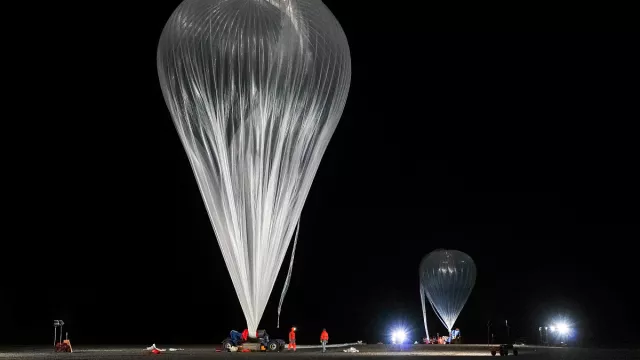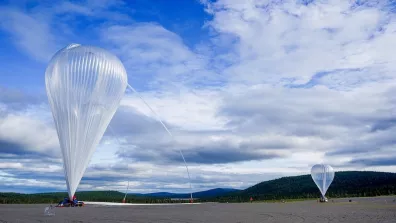CNES has pursued one of the most extensive balloon programmes in the world for over 60 years. Balloons are the only vehicles capable of studying the atmosphere in situ for long periods at altitudes of up to 40 kilometres.
Key information
| Mission | Study the atmosphere, astrophysics, meteorology and biology |
|---|---|
| Domain | Earth observation, Science |
| Start date | 1960 |
| Partners | LATMOS (ex-CETP), LMD, LPC2E, LERMA (ex-LPMAA), GSMA, LOA, LSCE, CNRM, IGE (ex-LGGE), IRAP, IAS, LAM, INSERM |
| Where | 0 to more than 40-km altitude |
| Lifetime | Indefinite |
| Status | In operation |
Key figures
- 60 years of balloon activities at CNES
- 20- to 40-km altitudes
- 4 main balloon families (ZPB, SSB, manoeuvrable, dilatable)
- >~4,000 balloons flown by CNES since 1961
Key milestones
- 2024: First transatlantic ZPB flight between Sweden and Canada
- 2019: First Strateole-2 flight campaign in Seychelles
- 2017: Flight campaign from Alice Springs launch base, Australia
- 2014: First scientific flight campaign from Timmins launch base, Canada
- 2013: Qualification of new secure aerostatic system for ZPBs
- 2005: Antarctic flight campaign, McMurdo station
- 1997: First long-duration circumpolar flights in winter
- December 1982: First round-the-world flight of scientific experiment by an infrared hot-air balloon
- 6 August 1977: First trans-Mediterranean flight (Sicily-Spain)
- 1966: Balloon launch centre opened at Gap-Tallard, France
- 12 September 1964: Official opening of Aire-sur-l’Adour balloon launch centre, attached to CNES
- February 1962: First balloon releases outside mainland France, in the Kerguelen Islands
- October 1961: Launch of first CNES stratospheric balloons
- 4 June 1783: First flight of a hot-air aerostat, the Montgolfier balloon
Project in brief
Capable of remaining at an altitude of 20 to 40 kilometres, higher than aircraft and for longer than sounding rockets, balloons remains unique vehicles for collecting data in situ in the stratosphere. Balloons are also an environmentally-friendly platform in that they use neither an engine nor fuel to reach their final destination.
Since the late 19th century, scientists have mostly used balloons to study the atmosphere or for astronomical research.
In the atmosphere, balloon-borne instruments can acquire in-situ measurements of winds, greenhouse gases, aerosols and radiation. Balloons also enable astronomers to observe the universe through telescopes weighing several hundred kilograms flown above the dense layers of the atmosphere.
Balloons can thus complement satellite observations and ground-based measurements.
Balloons drift through the atmosphere, enabling scientists to study physical and chemical phenomena and take air samples. For example, they have been used to study the ozone layer, to search for greenhouse gases and particles, and to investigate monsoon mechanisms in India and Africa.
With the development of space activities, the range of balloon applications has widened to include testing of new technologies. Instruments and equipment designed to be flown on satellites—like star trackers, thermal cameras and solar cells—are tested under balloons at very high altitudes.
Balloons meet the needs of many scientific communities. Astronomers use balloons flying above the dense layers of the atmosphere to capture invisible radiation that either scarcely reaches the ground—like infrared or ultraviolet rays—or not at all, like X-rays and gamma rays. Astrophysicists take advantage of certain flights to validate instrument techniques while collecting valuable science data.
Balloons are sometimes sent up to high altitudes to release the mock-up of a body for re-entry into Earth’s atmosphere (e.g., the heat shield of a planetary probe, a suborbital aircraft, a space shuttle, a decelerator for Mars, etc.) to study aerodynamics on a more representative scale than in a wind tunnel.
CNES’s role
Created at the instigation of the scientific community in the early 1960s, and then taken over and developed by CNES, the Balloon programme consists in designing and operating aerostats to carry scientific instruments or test new technologies.
CNES is involved in numerous balloon projects:
IN-AIR (Infrastructure Nationale des Aéronefs Instrumentés pour la Recherche)
This infrastructure operates a vast flotilla of instrumented aircraft and lighter-than-air vehicles to conduct a range of Earth and space observations, and to validate innovative aviation and space technologies for the scientific community. These include:
- Flying laboratories (ATR 42 and Piper Aztec aircraft) carrying scientific payloads of up to two tonnes
- Zero-pressure stratospheric balloons (ZPB), the only way to loft scientific payloads of several hundreds of kilograms into the stratosphere
- Superpressure balloons able to acquire measurements in the tropopause for up to several months
- Weather balloons able to sound the troposphere and stratosphere with limited payloads
Flight data are exploited through a central database developed in partnership with the Data Terra research infrastructure’s AERIS data and services hub.
MAGIC: Releases of balloon-borne atmospheric sounding instruments combined with aerial surveys to measure concentrations of carbon dioxide and methane, the two main human-induced greenhouse gases. The SAFIRE fleet of instrumented aircraft, national weather service Meteo France and national scientific research centre CNRS are partnering CNES on this project. Flight campaigns began in 2018 and the most recent was in 2023.
Learn more
STRATO-SCIENCE: Stratospheric balloon flight campaign operated by CNES and the Canadian Space Agency (CSA). The first campaign ran from August to September 2014 from the Timmins base in Canada. Balloons carrying the PILOT and SPECIES instruments were notably launched during the 2015, 2018, 2019 et 2023 campaigns. The most recent campaign took place from August to September 2023 at Timmins.
Learn more
AUSTRAL: Three launches of stratospheric balloons from CNES and CSA were made from Alice Springs, Australia, from 17 March to 21 April 2017.
Learn more
TRANSAT: Campaign in 2024 from the Esrange launch base in northern Sweden, operating short-duration ZPB flights over Scandinavia and long-duration flights like the transatlantic balloon recovered in the Canadian Arctic.
STRATEOLE 2: Project dedicated to studying atmospheric phenomena around the equator. It is being led by France with research scientists from the United States and other nations. It operates balloons capable of staying aloft for more than three months at altitudes of 18 to 20 kilometres. The first science campaign took place over the winter of 2021-2022. The second and last campaign is scheduled for the winter of 2026-2027.
Learn more
BalMan: Manoeuvrable stratospheric balloon capable of controlling its flight trajectory. Project in development.
Learn more
JEM-EUSO Collaboration: Stratospheric balloon-borne experiments designed to demonstrate the ability to detect cosmic rays penetrating Earth’s atmosphere from space. Flights took place in August 2014 (EUSO-ZPB), April 2017 (EUSO-SPB) and May 2023 (EUSO-SPB2). A EUSO-SPB3 flight is under study for 2025.
Learn more
FIREBall: (Faint Intergalactic Redshifted Emission Balloon) is a French-U.S. stratospheric-balloon-borne experiment conceived to detect the faint and diffuse emission of the intergalactic medium. The experiment flew for the first time on 22 July 2007 and is still ongoing. The most recent flight was on 25 September 2023. It is borne by a ZPB.
Learn more
PILOT: An international project led by CNES and the IRAP astrophysics and planetology research institute to measure the submillimetre polarized emission from interstellar dust for the first time on three stratospheric balloon flights (borne by a ZPB) between 2015 and 2019.
Learn more
SPECIES: (SPECtromètre Infrarouge à lasErs in Situ) is a rackable instrument to acquire targeted measurements of major and trace gases in Earth’s atmosphere that can be carried inside a stratospheric balloon gondola or aircraft, or operated on the ground. CNES is partnering the Canadian Space Agency (CSA) and the LPC2E environmental and space physics and chemistry laboratory, which is developing this infrared spectrometer built around OFCEAS technology (Optical Feedback Cavity Enhanced Absorption Spectroscopy). The first flight took place in August 2018 from Timmins, Canada. The experiment is borne by a ZPB.
Learn more
CNES contacts
Balloons Project Leader
Stéphane Louvel
E-mail: stephane.louvel at cnes.fr
Balloons subject matter expert
Adrien Deschamps
E-mail: adrien.deschamps at cnes.fr
CNES project managers
STRATEOLE 2
Stéphanie VENEL
E-mail: stephanie.venel at cnes.fr
FIREBALL
Nicolas BRAY
E-mail: nicolas.bray at cnes.fr
Balloon Maneuvering
François VACHER
E-mail: françois.vacher at cnes.fr
Resources
The documents below are available in open access. The CNES cannot be held responsible for any discrepancies with the latest configurations in force, nor in the event of anomalies relating to the use of this information for applications not carried out by the CNES.




